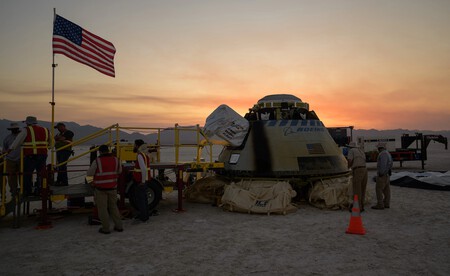For years, Starliner was presented as Boeing’s opportunity to aspire to a leading role in American manned flights, in a scenario in which SpaceX was advancing faster with Dragon. The contract signed with NASA in 2014 represented that opportunity: six manned flights and an open door to a new cycle of missions. Eleven years later, the situation is different. That agreement has been adjusted and the next mission has become an exam without people on board.
That agreement placed Starliner within the program with which the US space agency sought to guarantee two different US vehicles to the International Space Station. The idea was clear: have more than one capsule capable of transporting astronauts, long-term planning and autonomy in low orbit. That document established that, once the ship was certified, Boeing would operate six manned flights for regular rotations. All this with an eye on the station’s deadline, scheduled for 2030.
A shortened contract, by mutual agreement. NASA and Boeing have decided to modify the conditions of the original agreement and reduce the number of guaranteed flights. Instead of the six manned missions planned after certification, the new scenario includes a mission without astronauts, intended to validate the system, and up to three crew rotations. In addition, there are two optional flights that NASA can activate depending on its mission needs. This review also reduces the value of the contract, which goes from $4.5 billion to $3.732 million, after deducting $768 million.
Starliner-1 changes roles. This mission without astronauts has a name: Starliner-1, and it has become a key piece of the system validation plan. NASA will use it to send cargo to the International Space Station and verify, in real conditions, that the changes introduced after the manned flight in 2024 offer sufficient guarantees. The target date remains no earlier than April 2026, provided the spacecraft successfully completes testing, certification and pre-launch preparation.
A history of setbacks: The first warning came with the OFT-1 flight in December 2019, when some problems prevented Starliner from completing the planned profile and approaching the International Space Station. The mission had to be terminated early. In 2022, the OFT-2 flight managed to reach the station, but problems appeared in several thrusters. Two years later, during the first manned flight, several thrusters failed again on approach, leading NASA to order the return of the ship without the astronauts.

NASA and Boeing engineers inspect the Starliner spacecraft after landing in White Sands, New Mexico, during the OFT-2 orbital test in May 2022
When NASA decided that Starliner would not bring Butch Wilmore and Suni Williams back, they both extended their stay on the International Space Station much longer than planned. In total it was nine months, until the agency scheduled a Dragon flight with two fewer astronauts than usual to have enough space. That landing, in March 2025, allowed the return to be completed and confirmed that the evaluation process on Starliner was still open after the 2024 manned flight.
Meanwhile, Dragon. In parallel, Dragon began operating with astronauts in 2020 and was progressively incorporated into NASA’s regular planning. Since then, the SpaceX capsule has covered the planned rotations within the Commercial Crew Program, becoming the vehicle regularly used to access the International Space Station. In August 2025, the Crew-11 mission was completed, and Crew-12 is scheduled for February 2026. NASA has booked additional flights with Dragon until the station’s operational end, scheduled for 2030.


Less flights, less income, more pressure. The contract modification also means a change in Boeing’s position within the program. The reduction of the total value to 3,732 million dollars implies 768 million dollars less compared to the original figure, with fewer guaranteed flights and a greater weight of optional missions. According to Reuters, the company has invested more than $2 billion since 2016 in this development, which adds relevance to Starliner’s performance in upcoming flights. Despite this, Boeing says it remains committed to the program.
Redundancy against the clock. For NASA, Starliner remains relevant because the agency wants two independent systems that can transport astronauts to the International Space Station. Steve Stich, head of the Commercial Crew Program, summarized it by pointing out that the plan involves certifying the ship in 2026, scheduling its first manned rotation when it is ready and coordinating future flights according to the operational needs of the station, which will remain active until 2030. Maintaining this double capacity is key so that the agency does not depend exclusively on a single vehicle.

What happens from now on will depend on the outcome of the next flights. If the system manages to be certified in 2026, Starliner can still participate in up to three crewed rotations, with two additional options subject to NASA decision. Boeing maintains its commitment and suggests that the ship could have a place in commercial projects after the end of the International Space Station, although these scenarios are yet to be defined. The opportunity has not disappeared, but it no longer looks as much like the one signed in 2014.
Images | NASA (1, 2) | Boeing
In WorldOfSoftware | Starship’s great hope has gotten off to a bad start: a new and painful explosion










